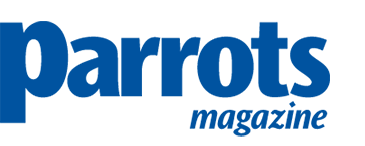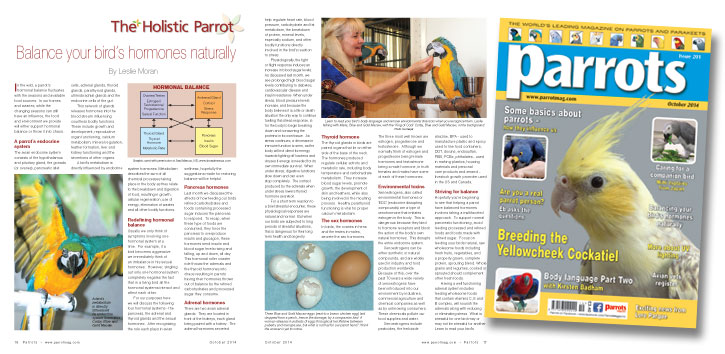
Balance your bird’s hormones naturally
By Leslie Moran
In the wild, a parrot’s hormonal balance fluctuates with the seasons and available food sources. In our homes and aviaries, while the changing seasons can still have an influence, the food and environment we provide will either support hormonal balance or throw it into chaos.
The avian endocrine system consists of the hypothalamus and pituitary gland, the gonads (or ovaries), pancreatic islet cells, adrenal glands, thyroid glands, parathyroid glands, ultimobrachial glands and the endocrine cells of the gut.
This network of glands releases hormones into the blood stream influencing countless bodily functions. These include growth and development, reproductive organ functioning, calcium metabolism, mineral regulation, feather formation, liver and kidney functioning and the secretions of other organs.
A bird’s metabolism is directly influenced by endocrine system hormones. Metabolism describes the sum of all chemical processes taking place in the body as they relate to the breakdown and digestion of food, resulting in growth, cellular regeneration, use of energy, elimination of wastes and all other bodily functions.
Buy Now!
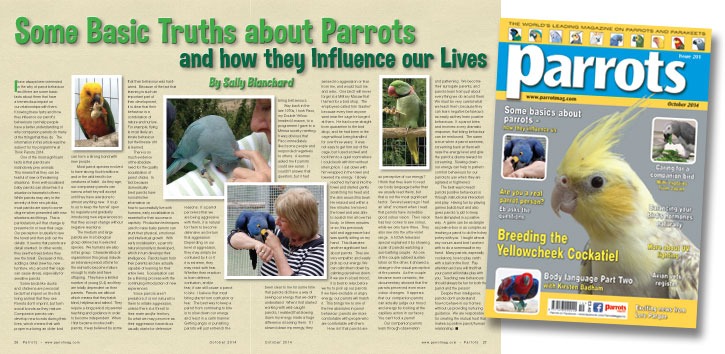
Some Basic Truths about Parrots and how they Influence our Lives
By Sally Blanchard
I have always been interested in the why of parrot behaviour and there are some basic facts about them that have a tremendous impact on our relationships with them. Knowing these facts and how they influence our parrot’s behaviours can help people have a better understanding of why companion parrots do many of the things that they do. The information in this article was the subject for my programme at Think Parrots 2014.
One of the most significant facts is that parrots are instinctively prey animals. This means that they can be fearful of new or threatening situations. Even well-socialised baby parrots can show fear if a situation is traumatic to them. While parrots may vary in the severity of their neo-phobia, most parrots are wary to some degree when presented with new situations and things. This is particularly true if that change is presented in or near their cage. Our perception is usually to see the forest and then pick out the details. It seems that parrots are detail oriented. In other words, they see the trees before they see the forest. Because of this, adding a detail (new toy, new furniture, etc.) around their cage can cause stress, especially for sensitive parrots.
Buy Now!
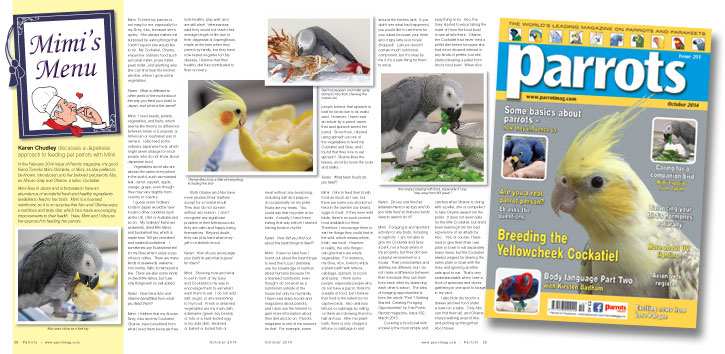
Karen Chudley discusses a Japanese approach to feeding pet parrots with Mimi
In the February 2014 issue of Parrots magazine, my good friend Tomoko Mimi Shimada, or Mimi, as she prefers to be known, introduced us to her beloved pet parrots Abo, an African Grey and Okame, a lutino Cockatiel.
Mimi lives in Japan and is fortunate to have an abundance of wonderful fresh and healthy ingredients available to feed to her birds. Mimi is a licensed nutritionist, so it is no surprise that Abo and Okame enjoy a nutritious and tasty diet, which has made encouraging improvements to their health. Here, Mimi and I discuss her approach to feeding her parrots.
Buy Now!
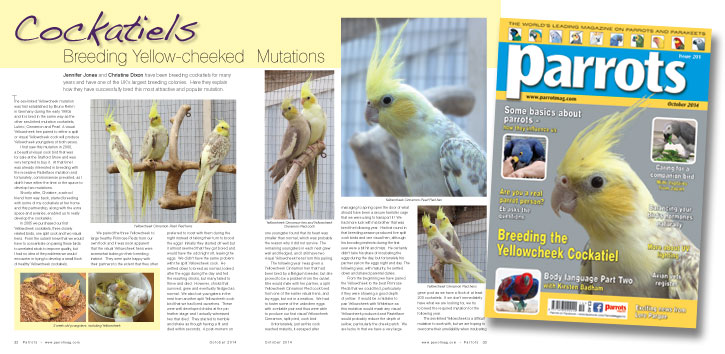
Cockatiels: Breeding Yellow-cheeked Mutations
Jennifer Jones and Christine Dixon have been breeding cockatiels for many years and have one of the UK's largest breeding colonies. Here they explain how they have successfully bred this most attractive and popular mutation.
The sex-linked Yellowcheek mutation was first established by Bruno Rehm in Germany during the early 1990s and it is bred in the same way as the other sex-linked mutation cockatiels, Lutino, Cinnamon and Pearl. A visual Yellowcheek hen paired to either a split or visual Yellowcheek cock will produce Yellowcheek youngsters of both sexes.
Buy Now!

